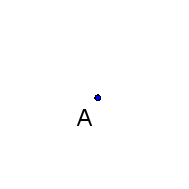Point (geometry): Difference between revisions
Jump to navigation
Jump to search

imported>Boris Tsirelson (correction) |
imported>Boris Tsirelson (correction) |
||
| Line 12: | Line 12: | ||
Any [[line (geometry)|line]] can be completely defined by two distinct points. | Any [[line (geometry)|line]] can be completely defined by two distinct points. | ||
Any [[plane (geometry)|plane]] can be completely defined by three distinct points that are not all part of the same [[line (geometry)|line]]. | Any [[plane (geometry)|plane]] can be completely defined by three distinct points that are not all part of the same [[line (geometry)|line]]. | ||
Any two [[line (geometry)|lines]] that lay on a single [[plane (geometry)|plane]] and are not [[parallel (geometry)|parallel]] | Any two [[line (geometry)|lines]] that lay on a single [[plane (geometry)|plane]] and are not [[parallel (geometry)|parallel]] (nor coincide) intersect at a single point. | ||
Three [[plane (geometry)|planes]] typically intersect at a single point (though in special cases their intersection can be a line or even a plane). | Three [[plane (geometry)|planes]] typically intersect at a single point (though in special cases their intersection can be a line or even a plane). | ||
Revision as of 09:35, 5 April 2010
A point is a mathematical object in geometry which has a position but neither length nor breadth nor depth. A point is made up of no other parts. The extremities of a line segment are points.
A line is made up of an infinite number of points. Any line can be completely defined by two distinct points. Any plane can be completely defined by three distinct points that are not all part of the same line. Any two lines that lay on a single plane and are not parallel (nor coincide) intersect at a single point. Three planes typically intersect at a single point (though in special cases their intersection can be a line or even a plane).

